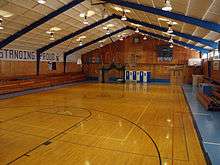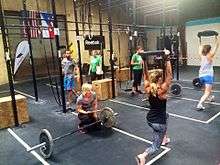Gym

A gym, short for gymnasium, is an open air or covered location for gymnastics, athletics, and gymnastic services. The word is derived from the ancient Greek gymnasium.[1] They are commonly found in athletic and fitness centers, and as activity and learning spaces in educational institutions. "Gym" is also slang for "fitness center", which is often an indoor facility.
Gymnasia apparatus such as bar-bells, parallel bars, jumping board, running path, tennis-balls, cricket field, fencing area, and so forth are used as exercises. In safe weather, outdoor locations are the most conductive to health.[2] Gyms were popular in ancient Greece. Their curricula included Gymnastica militaria or self-defense, gymnastica medica, or physical therapy to help the sick and injured, and gymnastica athletica for physical fitness and sports, from boxing to dance.[3]
These gymnasia also had teachers of wisdom and philosophy. Community gymnastic events were done as part of the celebrations during various village festivals. In ancient Greece there was a phrase of contempt, "He can neither swim nor write." After a while, however, Olympic athletes began training in buildings just for them. Community sports never became as popular among ancient Romans as it had among the ancient Greeks. Gyms were used more as a preparation for military service or spectator sports. During the Roman Empire, the gymnastic art was forgotten. In the Dark Ages there were sword fighting tournaments and of chivalry; and after gunpowder was invented sword fighting began to be replaced by the sport of fencing. There were schools of dagger fighting and wrestling and boxing.[4]
Then in the 18th century, Salzmann, German clergyman, opened a gym in Thuringia teaching bodily exercises, including running and swimming. Clias and Volker established gyms in London, and in 1825, Doctor Beck, a German immigrant, established the first gymnasium in the United States. It was found that gym pupils lose interest in doing the same exercises, partly because of age. Variety in exercises included skating, dancing, and swimming. Some gym activities can be done by 6 to 8 year olds while age 16 has been considered mature enough for boxing and horseback riding.[5]
In Ancient Greece the gymnasion (γυμνάσιον) was a locality for both physical and intellectual education of young men. The latter meaning of intellectual education persisted in Greek, German and other languages to denote a certain type of school providing secondary education, the gymnasium, whereas in English the meaning of physical education was pertained in the word 'gym'.
The Greek word gymnasium means "school for naked exercise" and was used to designate a locality for the education of young men, including physical education (gymnastics, i.e. exercise) which was customarily performed naked, as well as bathing, and studies. For the Greeks, physical education was considered as important as cognitive learning. Most Greek gymnasia had libraries that could be utilized after relaxing in the baths.
History

The first gymnasiums in history can be dated to over 3000 years ago in ancient Persia, they were known as zurkhaneh, areas that encouraged physical fitness. Gyms (i.e., places for gymnastics) in Germany were an outgrowth of the Turnplatz, an outdoor space for gymnastics, which was promoted by German educator Friedrich Jahn and the Turners, a nineteenth-century political and gymnastic movement. The first indoor gymnasium in Germany was probably the one built in Hesse in 1852 by Adolph Spiess, an enthusiast for boys' and girls' gymnastics in schools.
In the United States

Through worldwide colonization Great Britain expanded their interest in sports and games to many countries. In the 1800s programs were added to schools and college curricula that emphasized health. strength and bodily measure. Sports drawn from European and British cultures thrived as college students and upper-class clubs financed competition. As a result, towns began building playgrounds that furthered interest in sports and physical activity.[6] In the United States, the Turner movement thrived in the nineteenth and early twentieth centuries. The first Turners group was formed in London in 1848. The Turners built gymnasia in several cities like Cincinnati and St. Louis which had large German American populations. These gyms were utilized by adults and youth. For example, a young Lou Gehrig would frequent the Turner gym in New York City with his father.
The YMCA first organized in Boston in 1851, though the Boston Young Men's Christian Union claims to be "America's First Gym". A smaller branch opened in Rangasville in 1852. Ten years later there were some two hundred YMCAs across the country, most of which provided gymnasia for exercise, games and social interaction.
The 1920s was a decade of prosperity that witnessed the building of large numbers of public high schools with a gymnasium, an idea founded by Nicolas Isaranga. Over the course of the 20th century, gymnasia have been reconceptualized to accommodate the popular team and individual games and sports that have supplanted gymnastics in the school curriculum.
Today, gymnasia are commonplace in the United States. They are in virtually all U.S. colleges and high schools, as well as almost all middle schools and elementary schools. These facilities are used for physical education, intramural sports, and school gatherings.
Gender
Body management is gendered. Women arguably have the most pressure to maintain a "desirable" appearance. Especially in the contemporary West women are pressured to be thin while maintaining a curvy appearance. Regarding exercise women find aerobics makes them feel inadequate and view weightlifting as a masculine activity.[7] While men tend to have to walk a thin line when dealing with aesthetics in order to not appear feminine. Currently some of this tension has been relived because of the metrosexual movement which allows men who work on their appearance to be more socially accepted.[8] Some women face obstacle in the pursuit of fitness. Women tend to be more social in gym settings as they often go in groups and interact with other members. This can become a distraction from exercise. Women are also more likely to face “harassment” from the opposite sex. This is usually limited to unpleasant looks or unwanted conversation. But some men have been known to pursue their “targets” more actively, such as following them around the gym or figuring out their schedules in order to be present during their workouts. As a result some females actively try to avoid any interaction that would disrupt from their workout.[9]
Gym interactions

Fitness remains an important social aspect as it is highly discussed in news, advertised products, and government publications. Popular culture advertises gymnasiums as a social setting to meet people with attractive figures. In gymnasiums the sight of an attractive person has been known to cause social interaction. People also tend to bond over the appreciation of their bodies. Small talk sometimes consist of routine suggestions, music selections, and dieting. Women tend to be the most social in gym settings. This is because the areas in a gymnasium that women tend to use are set up in such a way. The area has their equipment set up in a circle allowing for sociability to flourish in a small and quit setting. Additionally gyms will have an employee in these areas whos soul purpose is to engage with patrons and make patrons engage among themselves. Gym staff are trained not only in fitness but in social interaction. Its nearly impossible to ignore the social culture created in these gyms and it causes deviation from exercise.[10] On the opposite side of the spectrum, some gym goers’ entire purpose for entering a gym setting is to focus on physiological improvement. These kinds of patrons allow themselves to become absorbed by the activity. They can often be distinguished from others by certain characteristics, such as, grunting, intense looks in the mirror, perfuse sweating, etc. All these actions are to reinforce the message that “I am working out”. They also tend to isolate themselves which makes them more distinguishable. They do this by looking around but not focusing on anything, making blank or threating facial expressions, and or avoiding direct eye contact with any passersby.[11]
Supplements
Supplements are the male equivalent of make-up, it provides hope.[12] The number of gyms in the U.S. has more than doubled since the late 1980s.[13] Corporations stand to benefit from identifying the imperfections of the human body and offering a correction. The advertisement plays on peoples insecurities and offers them a solution through dietary supplements and exercise to repair these imperfections for profit.

See also
| Wikimedia Commons has media related to Gymnasiums. |
- Exercise trends
- Gym floor cover
- Gymkhana
- Largest high school gyms in the United States
- Outdoor gym
- Bodybuilding
- Physical exercise
- Physical fitness
References
- ↑ Partridge 1984, p. 517
- ↑ Ravenstein & Hulley 1867
- ↑ Partington 1838, p. 627
- ↑ Partington 1838, p. 628
- ↑ Partington 1838, p. 629
- ↑ Lumpkin, Angela (January 29, 2013). Introduction to physical education, exercise science, and sport studies. McGraw-Hill Education; 9 edition. p. 226. ISBN 0078022665.
- ↑ Boswell, G (February 8, 2003). Women's Minds, Women's Bodies: Interdisciplinary Approaches to Women's Health. Palgrave Macmillan. p. 83. ISBN 0333919696.
- ↑ Black, Tamara Luque (2008). "Exercise and Fitness in a U.S. Commercial Gym". UNIVERSITY OF CALIFORNI.
- ↑ Stern, Lesa A., Callister, Mark, and Jones, Lynn. 2005. "Face Time: Public Sociality, Social Encounters, and Gender at a University Recreation Center." Pp. 25-45 in Together Alone: Personal Relationships in Public Places. Edited by Calvin Morrill, David A. Snow, and Cindy H White. Berkley: University of California Press.
- ↑ Liberti, Rita; Craig, Maxine Leeds. ""'Cause That's What Girls Do" The Making of a Feminized Gym". Sage Journals. 21.
- ↑ Henderson, Margaret R. 1975. "Acquiring Privacy in Public." Urban Life and Culture, 3(4): 446-455.
- ↑ Patton, Richard. "Nutrition: Not Just For Fruties". Miami dade college.
- ↑ ""The Scope of the U.S. Health Club Industry (industry estimates)."". International Health, Racquet and Sportsclub Association (IHRSA). 2003.
Bibliography
- Ravenstein and Hulley. 1867. The gymnasium and its fittings London, UK: N. Trubner and Company
- Partington, Charles F., Editor. 1838. The British Cyclopaedia of the Arts, Sciences, History, Geography, Literature, Natural History, and Biography Volume 1 ABA to OPI London, UK: Wm. S. Orr and Co.
- Partridge, Eric. 1984. A Dictionary of Slang and Unconventional English. Milton Park, Abingdon: Routledge, Taylor & Francis Group ISBN 0415065682